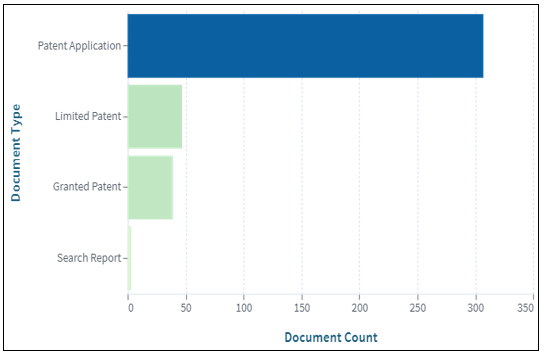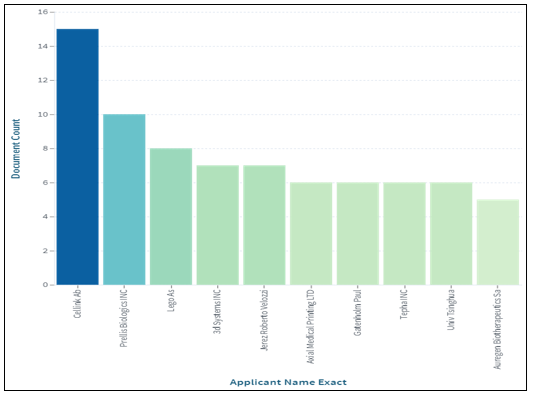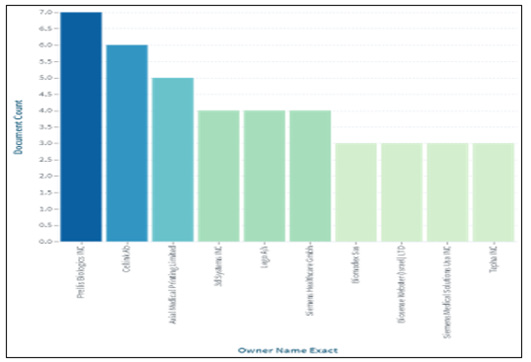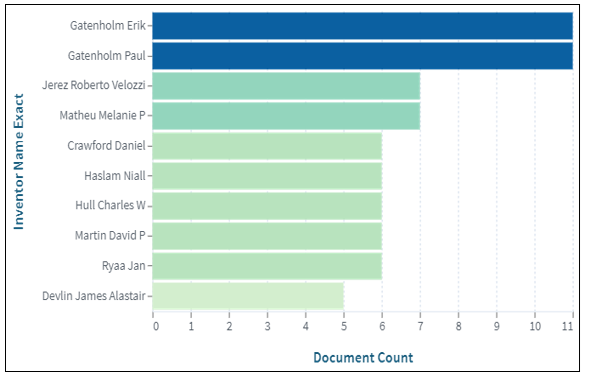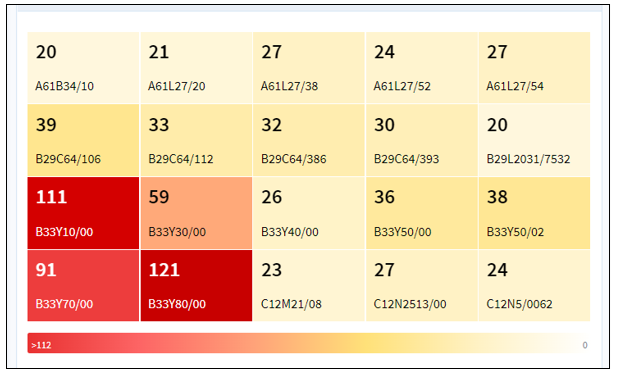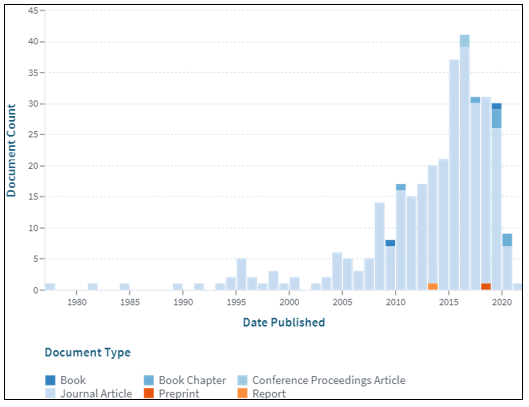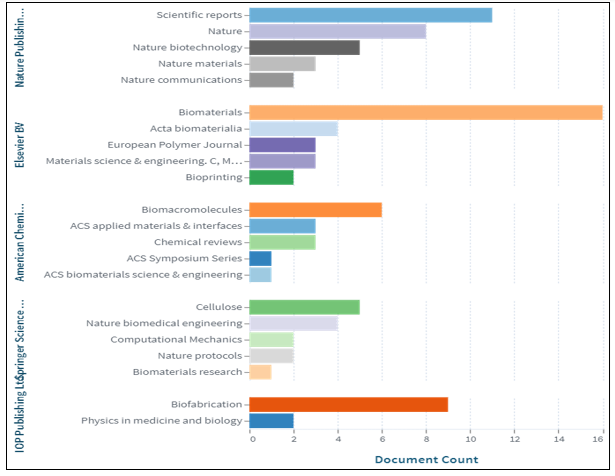ABSTRACT
3D printing technology is encompassing several domains from varied engineering streams to biological sciences. In biological sciences, 2D tissue culture techniques were known and followed. However, the emerging trend is the use of 3D printing technology. The evolution of biological sciences from very interesting G. Mendels simple experiments to classic restriction endonucleases, Polymerase chain reaction (PCR) technologies have followed an interesting path. Engineering applications in medical sciences resulted in the development of very complex machinery which is now an indispensable part of the healthcare industry. One such interesting emerging application is 3D printing. In this paper, the authors have tried to analyze the patent landscape related to this technology. Bird’s eye view of this 3D printing organ technology provides very interesting insights such as major players, countries in this domain, top researchers, and so on. The authors relied on secondary data and followed empirical research methodology. This analysis may help to develop policy, strategic research planning, technology transfer, future funding plan, etc.
Keywords: Organ Printing; 3D Printing; Patent; Landscape; Patinformatics
Introduction
Biological sciences development embarks very promising technologies such as restriction endonuclease, monoclonal antibodies, nude mice, dolly sheep, and so on. Artificial pacemakers, the use of bolts and plates in ortho surgery, prosthetic limbs, and so on helped human society to battle with unfortunate body damages. Further development where body organ transplant from donor to a receiver, in this domain is the practice of today with various challenges including graft rejection and so on. All these techniques and developments involved scientists, doctors, and associated service providers. However, considering the current population and demand for organs, tissue probably some new solutions are required to handle current challenges. Hence now scientists started thinking about the use of 3D printing for developing artificial organs. In this paper, we tried to understand this trend at a global level. We mainly focused on patent data related to this technology. The objective of the study is to understand the overall current development in this domain. The second objective is to know who are the leaders in this technology development. We hope that this data analysis may help researchers, practitioners, and policy makers working in this domain.
Literature Review
The field of tissue engineering is rapidly growing these days [1]. Traditional tissue engineering technologies had limited success in fabricating complicated 3D structures and in-vivo organ regeneration [2,3]. As a result, it is logistically and economically unsuitable for clinical use. In this regard, 3D bioprinting has been quite successful [4]. This is an extended application of additive manufacturing and involves a top-down approach of layer-by-layer building of complex tissue by deposition of matter in a controlled manner-resulting in anatomically accurate 3D models of the tissue mimicking the model generated by computer graphics [5,6]. There have been numerous number of patent applications filed in the field of bioprinting and organ printing. Studying a patent landscape of a technology gives an overall approach of country’s invention policies [7,8]. A patent analytics is always crucial for ensuring that the business or research is on the right track and offers future funding directions.
Research Methodology
Generally, an analysis of patent data over the last five years gives an overall idea about the technology trend. Therefore, the search has been restricted from January 1st, 2017 to the present date. The patent data has been downloaded from the LENS database on May 27th, 2020. The database has been last updated on May 19, 2022. LENS is an online patent search and analysis platform provided by an independent, international non-profit organization Cambia dedicated to democratizing innovation [9]. It has a collection of over 123.5 M patent records over 105 jurisdictions and 67.5 M patent families. The query string used is Patents (300) = Title: (3d AND (print* AND organ)) OR (Abstract: (3d AND (print* AND organ)) OR Claims: (3d AND (print* AND organ))). A total of 400 patents/ patent applications has been retrieved. After grouping down the patent families, the size collapsed to 301 documents.
Results and Discussion
Figure 1 shows the number of patent applications filed, published and granted since 2015. As can be seen, published and granted patent follow similar trend. This is logical, as the published patent applications are further going through examination and getting grants. The difference between the number of patent applications published and granted are around 40. Figure 2 shows that most of the documents used in the analysis are patent applications. However, there are around 50 granted patent also. (Figures 3-5) show the top applicant, owner, and inventors in this field. There are two main types of patent classifications—International patent classification by WIPO and Cooperative Patent Classification jointly developed by European Patent Office and US Patent and Trademark Office. Patent classifications help patent examiners and researchers to apply filter and select certain relevant patent applications/ patent in a particular technical field. Figure 6 shows the top IPC codes used to file patent applications for 3d organ printing technologies. As can be seen, B33Y is the major class. A search has been carried out in WIPO’s IPC database to understand what the code B33Y represents [10]. It is to be noted that B33 is for additive manufacturing technologies, and the subgroup B33Y includes “additive manufacturing, i.e. manufacturing of three-dimensional [3D] objects by additive deposition, additive agglomeration or additive layering, e.g. by 3d printing, stereolithography or selective laser sintering”. Next, we delve into the cited scholarly works from the patent documents studied in this section. Figure 7 shows how scholarly works are published over the years. Interestingly, the cited documents date way back in 1980s. As expected, most of the cited documents are journal articles. The first cited book is from 2009. Most of the works are going on in the USA, next in line is China. Then, we can see what are the top publishers where articles for 3D organ printing technologies are published and are cited in the patent/patent applications (Figure 8). As can be seen, Elsevier turned out to be the most popular publisher among the researchers in this area. The journal Biomaterials have published most of the articles submitted under the Elsevier umbrella.
Conclusion
The present study provided an analysis of patent and nonpatent data on 3D organ printing technologies for the last 5 years. Our analysis shows that most of the promising works are going on in the USA, while next in line is China. Cellink Ab, Prellis biologicals INC, Lego AS, 3D system inc, and Jerez Roberto Velozzi are top applicants. Cellink Ab, Prellis biologicals INC, and Axial medical printing ltd are leading in ownership of organ printing patents. Gatenholm Erik, Gatenholm Paul, Jerez Roberto Velozzi and Matheu Melanie P are the top inventors and interestingly Jerez Roberto Velozzi is applicant and inventor. According to IPC, B33Y is the major class with reference to this technology. It shows that the concept of 3D printing was proposed long back in literature. Since 1980, publications related to this domain are available. There are books, journal articles, conference publications focused on this domain. In 2010, we can see that lot of work is published. Considering this development probably in the near future organ transplantation domain will see a new shift.
References
- V Mironov, T Boland, T Trusk, G Forgacs, RR Markwald (2003) Organ printing: computer-aided jet-based 3D tissue engineering. Trends Biotechnol 21(4): 157-161.
- V Mironov, CD Vladimir Kasyanov RR Markwald (2007) Organ printing: promises and challenges. Regen Med 3(1): 93-103.
- Natalja E Fedorovich, J Alblas, WE Hennink, C Öner, WJA Dhert (2011) Organ printing: the future of bone regeneration? Trends Biotechnol 29(12): 601-606.
- Y Bozkurt, E Karayel (2021) 3D printing technology; methods, biomedical applications, future opportunities and trends. J Mater Res Technol 14: 1430-1450.
- S Agarwal, S Saha, VK Balla, A Pal, A Barui, et al. (2020) Current Developments in 3D Bioprinting for Tissue and Organ Regeneration–A Review. Front Mech Eng.
- A Bandyopadhyay, Y Zhang, S Bose (2020) Recent developments in metal additive manufacturing. Curr Opin Chem Eng 28: 96-104.
- (2015) WIPO/OMPI. Guidelines for Preparing Patent Landscape Reports. WIPO Mag.
- A Roy Chowdhury, G Gargate (2021) The trends in CRISPR research: A patent and literature study with a focus on India. World Pat Inf 65: 102038.
- https://www.lens.org.
- (2022) International Patent Classification (IPC).

 Research Article
Research Article
